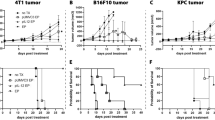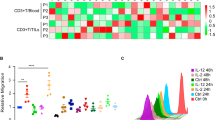Abstract
The expression of Fas ligand (FasL) by tumor cells has been reported to have multiple, conflicting effects on tumor growth. The majority of the data support the theory that FasL expressing tumor cells evade immune surveillance by killing T cells expressing Fas. However, the role of the humoral immune-blockade by FasL expressing tumor cells has not been assessed. Using immune-competent mice, we observed that FasL expressing tumor cells reduced the antitumor antibody production together with the T and B cell content of the spleen in these mice. Further, to determine if the expression of FasL in the environment of the tumor suppresses the humoral antitumor immune response and influences tumor growth, a mouse model lacking T cells was used. To assess whether a local reduction of FasL could reduce tumor progression, a plasmid encoding antisense FasL cDNA was delivered directly into a growing tumor (SW620 colon carcinoma). Intratumoral delivery of the plasmid was able to transfect tumor cells, stromal cells, and peritumoral muscle cells. This antisense FasL tumor tissue transfection persisted for at least 25 days, produced a systemic decrease in soluble FasL, and resulted in a 50% reduction in the rate of tumor growth when compared with tumor tissue of the control groups. These results suggest that direct transfection of antisense FasL cDNA impairs FasL translation in tumor and stromal cells, and can inhibit tumor progression by impairing the FasL-mediated, stromal cell-assisted, tumor counter-attack.
This is a preview of subscription content, access via your institution
Access options
Subscribe to this journal
Receive 12 print issues and online access
$259.00 per year
only $21.58 per issue
Buy this article
- Purchase on Springer Link
- Instant access to full article PDF
Prices may be subject to local taxes which are calculated during checkout



Similar content being viewed by others
References
Watanabe R et al. The cDNA structure, expression, and chromosomal assignment of the mouse Fas antigen J Immunol 1992 148: 1274–1279
Leithäuser F et al. Constitutive and induced expression of APO-1, a new member of the nerve growth factor/tumor necrosis factor receptor superfamily, in normal and neoplastic cells Lab Invest 1993 69: 415–429
French LE et al. Fas and Fas ligand in embryos and adult mice: ligand expression in several immune-privileged tissues and co-expression in adult tissues characterized by apoptotic cell turnover J Cell Biol 1996 133: 335–343
Schelling JR et al. Fas-dependent fratricidal apoptosis is a mechanism of tubular epithelial cell deletion in chronic renal failure Lab Invest 1998 78: 813–824
Ashany D et al. Th1 CD4+ lymphocytes delete activated macrophages through the Fas/APO-1 antigen pathway Proc Natl Acad Sci USA 1995 92: 11225–11229
Rensing-Ehl A et al. Local Fas/APO-1 (CD95) ligand-mediated tumor cell killing in vivo Eur J Immunol 1995 25: 2253–2258
White CA, McCombe PA, Pender MP . Microglia are more susceptible than macrophages to apoptosis in the central nervous system in experimental autoimmune encephalomyelitis through a mechanism not involving Fas (CD95) Int Immunol 1998 10: 935–941
Garrone P et al. Fas ligation induces apoptosis of CD40-activated human B-lymphocytes J Exp Med 1995 182: 1265–1273
Griffith TS et al. Fas ligand-induced apoptosis as a mechanism of immune privilege Science 1995 270: 1189–1192
Bennett MW et al. Expression of Fas ligand by human gastric adenocarcinomas: a potential mechanism of immune escape in stomach cancer Gut 1999 44: 156–162
Gutierrez LS et al. The Fas/Fas-ligand system: a mechanism for immune evasion in human breast carcinomas Breast Cancer Res Treat 1999 54: 245–253
Hahne M et al. Melanoma cell expression of Fas (Apo-1/CD95) ligand: implications for tumor immune escape Science 1996 274: 1363–1366
O'Connell J et al. The Fas counterattack: Fas-mediated T-cell killing by colon cancer cells expressing Fas ligand J Exp Med 1996 184: 1075–1082
Ungefroren H et al. Human pancreatic adenocarcinomas express Fas and Fas ligand yet are resistant to Fas-mediated apoptosis Cancer Res 1998 58: 1741–1749
Xerri L et al. Malignant and reactive cells from human lymphomas frequently express Fas ligand but display a different sensitivity to Fas-mediated apoptosis Leukemia 1997 11: 1868–1877
Peduto Eberl L et al. Fas and Fas ligand expression in tumor cells and in vascular smooth-muscle cells of colonic and renal carcinomas Int J Cancer 1999 81: 772–778
Brown SB, Savill J . Phagocytosis triggers macrophage release of Fas ligand and induces apoptosis of bystander leukocytes J Immunol 1999 162: 480–485
Yoong KF et al. Fas/Fas ligand interaction in human colorectal hepatic metastases: a mechanism of hepatocyte destruction to facilitate local tumor invasion Am J Pathol 1999 154: 693–703
Ju DW, Cao X, Acres B . Intratumoral injection of GM-CSF gene encoded recombinant vaccinia virus elicits potent antitumor response in a mixture melanoma model Cancer Gene Therapy 1997 4: 139–144
Morton D et al. Immunological factors which influence response to immunotherapy in malignant melanoma Surgery 1970 68: 158–163
Ramsdell F et al. Differential ability of Th1 and Th2 T-cells to express Fas ligand and to undergo activation-induced cell death Int Immunol 1994 6: 1545–1553
Alderson MR et al. Fas ligand mediates activation-induced cell death in human T lymphocytes J Exp Med 1995 181: 71–77
Mandik L et al. Fas receptor expression on B-lineage cells Eur J Immunol 1995 25: 3148–3154
Kume T et al. Relationship between Fas-ligand expression on carcinoma cell and cytotoxic T-lymphocyte response in lymphoepithelioma-like cancer of the stomach Int J Cancer 1999 84: 339–343
Rafi AQ et al. Evidence for the involvement of Fas ligand and perforin in the induction of vascular leak syndrome J Immunol 1998 161: 3077–3086
Allgaier B et al. Spontaneous and Fas-mediated apoptosis are diminished in umbilical cord blood neutrophils compared with adult neutrophils J Leuk Biol 1998 64: 331–336
Jane SM, Cunningham JM, Vanin EF . Vector development: a major obstacle in human gene therapy Ann Med 1998 30: 413–415
Lau HT et al. Prevention of islet allograft rejection with engineered myoblasts expressing FasL in mice Science 1996 273: 109–112
Kang SM et al. Immune response and myoblasts that express Fas ligand Science 1997 278: 1322–1324
Manfred V, Jürgen M, Reet K . Inverse correlation between apoptotic (Fas ligand, caspase-3) and angiogenic factors (VEGF, microvessel density) in squamous cell lung carcinomas Anticancer Res 1999 19: 1669–1675
Author information
Authors and Affiliations
Rights and permissions
About this article
Cite this article
Nyhus, J., Wolford, C., Feng, L. et al. Direct in vivo transfection of antisense Fas-ligand reduces tumor growth and invasion. Gene Ther 8, 209–214 (2001). https://doi.org/10.1038/sj.gt.3301372
Received:
Accepted:
Published:
Issue Date:
DOI: https://doi.org/10.1038/sj.gt.3301372
Keywords
This article is cited by
-
Therapeutic approaches targeting CD95L/CD95 signaling in cancer and autoimmune diseases
Cell Death & Disease (2022)
-
Fas-ligand gene silencing in basal cell carcinoma tissue with small interfering RNA
Gene Therapy (2005)
-
Fas Ligand Downregulation with Antisense Oligonucleotides in Cells and in Cultured Tissues of Normal Skin Epidermis and Basal Cell Carcinoma
Journal of Investigative Dermatology (2003)



